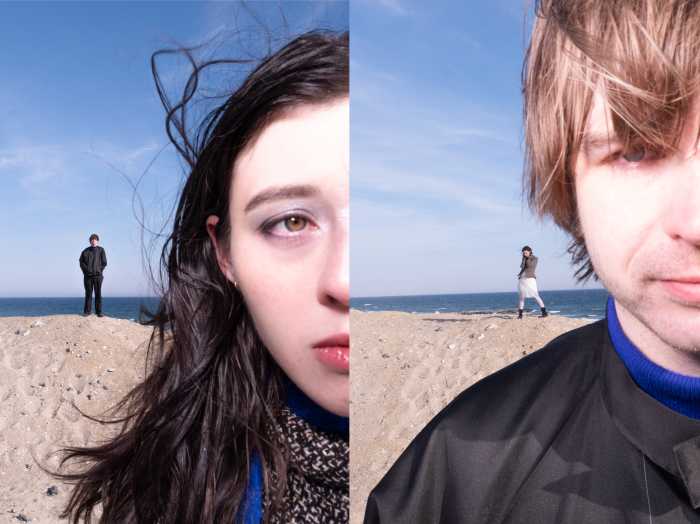This month, Gay City News reviews the latest albums by trans singer Ethel Cain and the rock band Water From Your Eyes, whose singer Rachel Brown is queer and non-binary.
Ethel Cain | “Willoughby Tucker, I’ll Always Love You” | Daughters of Cain | August 8th
In a period when individual songs take precedence over albums, Ethel Cain became a star with a lengthy conceptual project, “Preacher’s Daughter.” Cain is a character created by Hayden Anhedonia — yes, that’s her real name — as a way to narrate the life of a woman in a deeply religious southern community, surrounded by the threat of violence. Since Cain is murdered at the end of “Preacher’s Daughter,” her second studio album “Willoughby Tucker, I’ll Always Love You” takes the character back to 1986, five years before the story of her debut album. The songs relate the relationship between Cain and Tucker, whom she’s already mentioned on “A House In Nebraska.”
Cain's songs like “Crush” and “American Teenager” have proved her flair for pop, but she retains a distance from the genre. Even though the vinyl release of “Preacher’s Daughter” hit the Billboard top 10 earlier this year, she resists the notion that she’s become a star. When racist social media posts she made in 2017 were recently leaked, alongside more dubious allegations reeking of transphobia, the worst aspects of her chronically online roots came into view. “Preacher’s Daughter” identifies with women who’ve suffered abuse, with hints that the singer has personal experience of it. If she abandons the Cain character, as she’s proposed, will her music speak about the ugliness that an “American teenager” can perpetrate?
Earlier this year, Cain took a break from her cycle of narrative work with her defiantly uncommercial “Perverts,” a collection of 10-minute drones. Parts of her new album return to this mode in a briefer, more accessible manner, presenting long instrumental passages as dramatic build-up. “Radio Towers” hangs in the air like a cloud of smoke. “Dust Bowl” is a hungover crawl. The guitar on “A Knock at the Door” is recorded close enough to hear her pick scraping across it. Even when her music uses acoustic instruments, it never gives into the illusion that it’s an unmediated recording. While skillfully molded, her songs have the leisure to drift. The very slow crescendo of “Tempest” perfectly fits its title.
Although much of “Willoughby Tucker” is instrumental, it also continues Cain’s literary impulses. “F**k Me Eyes” tells a character study of a girl who’s notorious for sleeping around — “three years undefeated as Miss Holiday Inn…the boys can’t get enough of her” — through Cain’s eyes, as she mingles admiration, contempt and a bit of envy. The song on “Willoughby Tucker” with the most hit potential, it’s still far more introverted than “American Teenager.” While she shares a breathy voice and an overwhelming air of sadness with Lana del Rey, Cain’s more willing to stretch torch songs to their breaking points, letting them burn for 10 or 15 minutes. As her audience grows, she’s taken to amplifying the smallest gestures of her music. “Willoughby Tucker” grants moments of grace to the life of Cain’s namesake character.
Water From Your Eyes | “It’s a Beautiful Place” | Matador | August 22nd
[caption id="attachment_58501" align="aligncenter" width="700"]
 Water From Your Eyes' “It’s a Beautiful Place” comes out August 22.Adam Powell
Water From Your Eyes' “It’s a Beautiful Place” comes out August 22.Adam Powell[/caption]
In the midst of their seventh studio album, “It’s a Beautiful Place,” Water From Your Eyes throws out the query “You Do Believe In God?” It’s not answered in any obvious way, although the song’s wash of cosmic synthesizers implies a psychedelic mysticism. Later, “For Mankind” picks up the same thread. The band’s voice is an internal monologue. Some lyrics suggest topical subjects — “you’re in debt or well you’re nothing at all/tried to make it to the hereafter/wound up at the mall” — but instead of arriving at a conclusion, Rachel Brown lets them flow as free associated thoughts. Even when they flirt with pop — Lorde and Charli XCX supplied some of the genetic material for “Playing Classics” — they recede rather than blowing their songs up. Heavy guitars push her voice to the background during “Born 2.”
Through “It’s A Beautiful Place,” the music longs to transcend the flaws of this particular time and country. It sees possibilities which are extremely difficult to actually live out. “Born 2” says so directly: “born in between/this world is so beautiful/tied to machines.” This yearning was illustrated in their 2023 music video “Barley,” where they play bored office workers dreaming for open spaces and mountains. It’s no surprise to learn that Brown was inspired by sci-fi/fantasy writer Ursula LeGuin.
Water From Your Eyes expands upon post-punk rather than settling for an early ‘80s revival. With spoken vocals and scratchy guitar, “Life Signs” could’ve come from the London scene that produced Dry Cleaning and black midi. Since their studio lineup features just two members — Brown and multi-instrumentalist Nate Amos — much of Water From Your Eyes’ music boils down to guitar and drums. Amos overdubs small touches that expand the band’s palette. Even the shorter songs shift direction, switching time signatures. Despite its eclecticism, “It’s a Beautiful Place” still sounds cohesive, returning to textures like backwards tape loops. (In a brief half hour, it only includes six full-fledged songs, with the rest comprised of short instrumental interludes.) Brown’s presence as a vocalist remains consistent. Most of all, they suture together parts of songs that don’t quite fit without forcing them to do so. Yet the results cohere, offering a clear vision of the gap between dreary reality and dreams of a brighter life.

 Water From Your Eyes' “It’s a Beautiful Place” comes out August 22.Adam Powell[/caption]
In the midst of their seventh studio album, “It’s a Beautiful Place,” Water From Your Eyes throws out the query “You Do Believe In God?” It’s not answered in any obvious way, although the song’s wash of cosmic synthesizers implies a psychedelic mysticism. Later, “For Mankind” picks up the same thread. The band’s voice is an internal monologue. Some lyrics suggest topical subjects — “you’re in debt or well you’re nothing at all/tried to make it to the hereafter/wound up at the mall” — but instead of arriving at a conclusion, Rachel Brown lets them flow as free associated thoughts. Even when they flirt with pop — Lorde and Charli XCX supplied some of the genetic material for “Playing Classics” — they recede rather than blowing their songs up. Heavy guitars push her voice to the background during “Born 2.”
Through “It’s A Beautiful Place,” the music longs to transcend the flaws of this particular time and country. It sees possibilities which are extremely difficult to actually live out. “Born 2” says so directly: “born in between/this world is so beautiful/tied to machines.” This yearning was illustrated in their 2023 music video “Barley,” where they play bored office workers dreaming for open spaces and mountains. It’s no surprise to learn that Brown was inspired by sci-fi/fantasy writer Ursula LeGuin.
Water From Your Eyes expands upon post-punk rather than settling for an early ‘80s revival. With spoken vocals and scratchy guitar, “Life Signs” could’ve come from the London scene that produced Dry Cleaning and black midi. Since their studio lineup features just two members — Brown and multi-instrumentalist Nate Amos — much of Water From Your Eyes’ music boils down to guitar and drums. Amos overdubs small touches that expand the band’s palette. Even the shorter songs shift direction, switching time signatures. Despite its eclecticism, “It’s a Beautiful Place” still sounds cohesive, returning to textures like backwards tape loops. (In a brief half hour, it only includes six full-fledged songs, with the rest comprised of short instrumental interludes.) Brown’s presence as a vocalist remains consistent. Most of all, they suture together parts of songs that don’t quite fit without forcing them to do so. Yet the results cohere, offering a clear vision of the gap between dreary reality and dreams of a brighter life.
Water From Your Eyes' “It’s a Beautiful Place” comes out August 22.Adam Powell[/caption]
In the midst of their seventh studio album, “It’s a Beautiful Place,” Water From Your Eyes throws out the query “You Do Believe In God?” It’s not answered in any obvious way, although the song’s wash of cosmic synthesizers implies a psychedelic mysticism. Later, “For Mankind” picks up the same thread. The band’s voice is an internal monologue. Some lyrics suggest topical subjects — “you’re in debt or well you’re nothing at all/tried to make it to the hereafter/wound up at the mall” — but instead of arriving at a conclusion, Rachel Brown lets them flow as free associated thoughts. Even when they flirt with pop — Lorde and Charli XCX supplied some of the genetic material for “Playing Classics” — they recede rather than blowing their songs up. Heavy guitars push her voice to the background during “Born 2.”
Through “It’s A Beautiful Place,” the music longs to transcend the flaws of this particular time and country. It sees possibilities which are extremely difficult to actually live out. “Born 2” says so directly: “born in between/this world is so beautiful/tied to machines.” This yearning was illustrated in their 2023 music video “Barley,” where they play bored office workers dreaming for open spaces and mountains. It’s no surprise to learn that Brown was inspired by sci-fi/fantasy writer Ursula LeGuin.
Water From Your Eyes expands upon post-punk rather than settling for an early ‘80s revival. With spoken vocals and scratchy guitar, “Life Signs” could’ve come from the London scene that produced Dry Cleaning and black midi. Since their studio lineup features just two members — Brown and multi-instrumentalist Nate Amos — much of Water From Your Eyes’ music boils down to guitar and drums. Amos overdubs small touches that expand the band’s palette. Even the shorter songs shift direction, switching time signatures. Despite its eclecticism, “It’s a Beautiful Place” still sounds cohesive, returning to textures like backwards tape loops. (In a brief half hour, it only includes six full-fledged songs, with the rest comprised of short instrumental interludes.) Brown’s presence as a vocalist remains consistent. Most of all, they suture together parts of songs that don’t quite fit without forcing them to do so. Yet the results cohere, offering a clear vision of the gap between dreary reality and dreams of a brighter life. 
 Mark
Mark 





